Adenia epigea
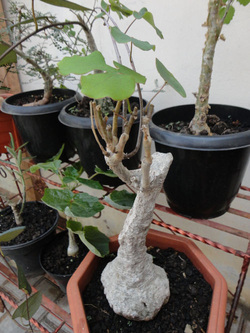
Found by Joseph Marie Henry Alfred Perrier de la Bâthie around 1910, but was given this name by him in 1940. It is found - in it's green form, growing in a well drained soil with some water and some to lots of sun. The caudex can grow to 20 centimetres or more in diameter, the plant can raise to 120 centimetres or more.
Habitat: centra and nothern of Madagascar
Habitat: centra and nothern of Madagascar
Adenia stylosa

Adenia stylosa (Perr.) D.J.Hearn (synonym: Adenia firingalavensis var. stylosa (H.Perrier) W.J.de Wilde) from northern Madagascar resembles Adenia firingalavensis, but molecular and morphological data suggest it is a separate species.
Adenia globosa
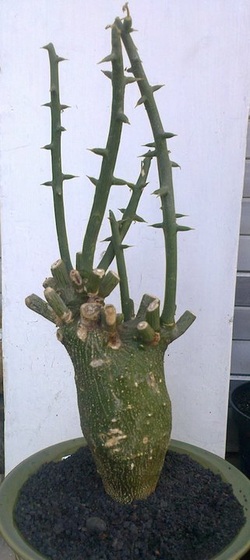
Described by Heinrich Gustav Adolf Engler in 1893.
Growing in a well drained soil with some to lots of water and some to lots of sun. The caudex can grow up to one meter in diameter, the vines can grow up to two meters long. The flowers are greenish white, and cuttings will form a nice caudex.
Habitat: Kenya, Somalia and Tanzania
Photo courtesy of Hendick Purwanto ([email protected])
Growing in a well drained soil with some to lots of water and some to lots of sun. The caudex can grow up to one meter in diameter, the vines can grow up to two meters long. The flowers are greenish white, and cuttings will form a nice caudex.
Habitat: Kenya, Somalia and Tanzania
Photo courtesy of Hendick Purwanto ([email protected])
Adenia spinosa
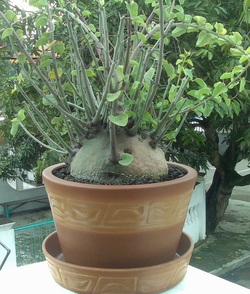
Dscribed by Joseph Burtt Davy in 1926.
Growing up to 2,5 meters in diameter, and 1,5 meters heigh. It prefers acid mixed soil, well watered in the summer. The flower is creme in colour.
Habitat: southern of Africa
Photo courtesy of Hendick Purwanto ([email protected])
Growing up to 2,5 meters in diameter, and 1,5 meters heigh. It prefers acid mixed soil, well watered in the summer. The flower is creme in colour.
Habitat: southern of Africa
Photo courtesy of Hendick Purwanto ([email protected])
Adenium socotranum

Described by Friedrich Vierhapper in 1904. It is found on Socotra, growing in grit or an other well drained soil with little to some water and lots of sun. The caudex can grow up to 2,5 meters and up to 3,5 meter in height. The flowers are pale pink.
Commiphora africana
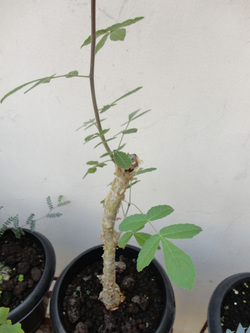
Named by Heinrich Gustav Adolf Engler in 1883. Growing in a well drained soil with little to some water and some to lots of sun. The stem can grow up to fifteen or even 30 centimetres in diameter and reach a height of two to six and a half meters. The flowers are brownish red.
Habitat: In most of Africa
Habitat: In most of Africa
Cyphostemma betiformis
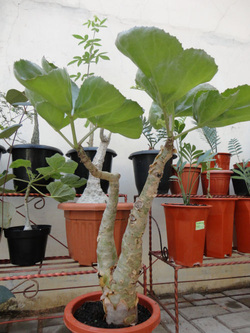
Named by Kaj Børge
Vollesen in 1984.Growing in a well drained soil with some water and lots of
sun. The stem can grow up to twelve centimetres in diameter and reach a
height of 60 centimetres. The flowers are greenish.
Habitat: Kenya and Somalia
Habitat: Kenya and Somalia
Dorstenia gigas
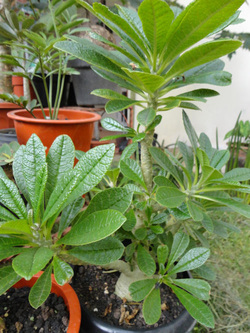
From Socotra, described by Georg August Schweinfurth 1883.
It grows on the rocky slopes, and id does not need a lot of water but lots of sun. The stem can grow up to 60 cm in diameter and get one and a half meter high.
It grows on the rocky slopes, and id does not need a lot of water but lots of sun. The stem can grow up to 60 cm in diameter and get one and a half meter high.
Fockea edulis
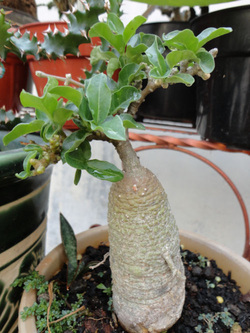
Named by Karl Moritz Schumann in 1895. It grows in a well drained soil with some water and some to lots of sun. The caudex can grow op to 60 cm in diameter, and the vines reach 4 meters in height.
One of the few caudiciforms with an eatable caudex.
Habitat: southern Africa
One of the few caudiciforms with an eatable caudex.
Habitat: southern Africa
Gerrardanthus macrorhizus
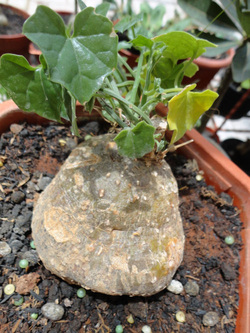
Described by Benth & Hooker, and then by William Henry Harvey in 1867.
Well-drained and rather rich soil with some water an not too much sun. The caudex can grow up to 1,5 meter, and the vines more than 10 meters.
Habitat: southern Africa
Well-drained and rather rich soil with some water an not too much sun. The caudex can grow up to 1,5 meter, and the vines more than 10 meters.
Habitat: southern Africa
Ipomoea bolusiana
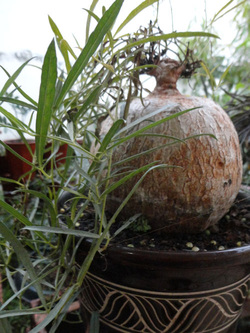
Describes by Hans Schinz in 1888. It is found in southern Africa and Madagascar, growing in a well drained soil with some water and lots of sun. The caudex can grow to 20 centimetres in diameter, the stems to three meters. The flowers are pink.
Nolina recurvata
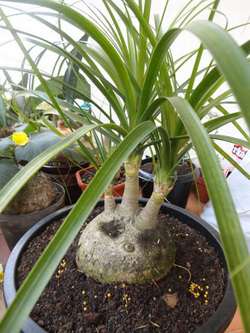
Known as Beaucarnea recurvata it is now accepted as Nolina recurvata. Related to the yuccas, this evergreen small tree has adapted to its dry habitat in Mexico
Operculicarya decaryi

Described by Joseph Marie Henry Alfred Perrier de la Bâthie in 1944.
Growing in well-drained soil with some water and lots of sun, but it can get too much. The stem will grow to one meter in diameter and reach for 9 meters. The flowers are dark red to brown and it's possible reproduce the plant by cuttings.
Habitat: south-west of Madagascar
Growing in well-drained soil with some water and lots of sun, but it can get too much. The stem will grow to one meter in diameter and reach for 9 meters. The flowers are dark red to brown and it's possible reproduce the plant by cuttings.
Habitat: south-west of Madagascar
Othonna calacoides
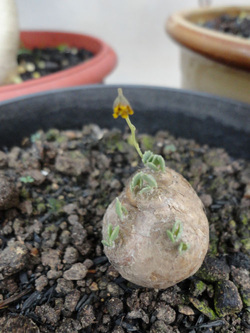
Described by Carl Linnaeus in 1781. Growing in grit, with little water and some sun. The caudex will get 30 centimetres in diameter, the leaves only 3 centimetres. The flowers are yellow, and it can be reproduced by cuttings as well.
Habitat: Namibia and Southern Africa,
Habitat: Namibia and Southern Africa,
Pachycormus discolor
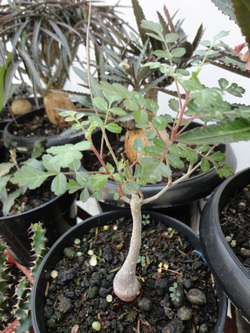
Named by Frederick Vernon Coville in 1911. It grows on lava-rubble or hillsides with little water and lots of sun. The stem can grow to one meter in diameter and reach 10 meters in height. The plentiful flowers are creme to pink.
Habitat: Baja California's west coast
Habitat: Baja California's west coast
Pterodiscus luridus
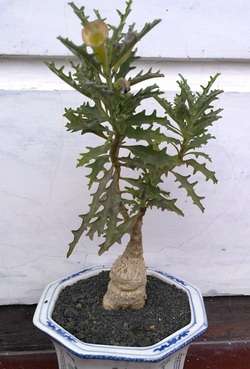
Described by Joseph Dalton Hooker in 1869.
Growing in a well-drained soil/grit with some water and lots of sun. The caudex can grow to 12 centimetres, the branches up to 45 centimetres in height. The flowers are pink with white throat. Difficult plant to cultivate, quiet easy from seeds.
Habitat: South Africa
Photo courtesy of Hendick Purwanto ([email protected])
Growing in a well-drained soil/grit with some water and lots of sun. The caudex can grow to 12 centimetres, the branches up to 45 centimetres in height. The flowers are pink with white throat. Difficult plant to cultivate, quiet easy from seeds.
Habitat: South Africa
Photo courtesy of Hendick Purwanto ([email protected])
Sinningia leucotricha
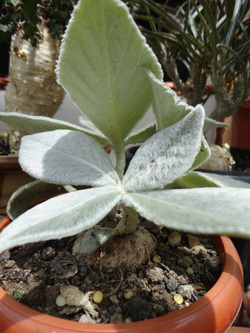
Named by Harold Emery Moore in 1973.
It grows in well-drained soil some water and lots of sun. The caudex will grow to 30 centimetres. The flowers are red and it can also be reproduced by cuttings from the caudex.
The caudex grows mostly below surface.
Habitat: Brazil
It grows in well-drained soil some water and lots of sun. The caudex will grow to 30 centimetres. The flowers are red and it can also be reproduced by cuttings from the caudex.
The caudex grows mostly below surface.
Habitat: Brazil
Uncaryna roeoesliana
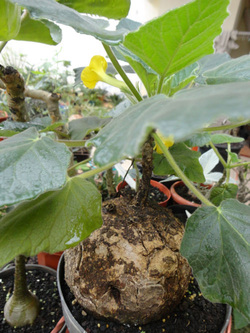
Described by Werner Rauh in 1996. It's from Madagascar, growing in well-drained soil with lots of water and sun. The stems reaches for 2 meters. The flowers are yellow, and it can be reproduced by cuttings as well.
